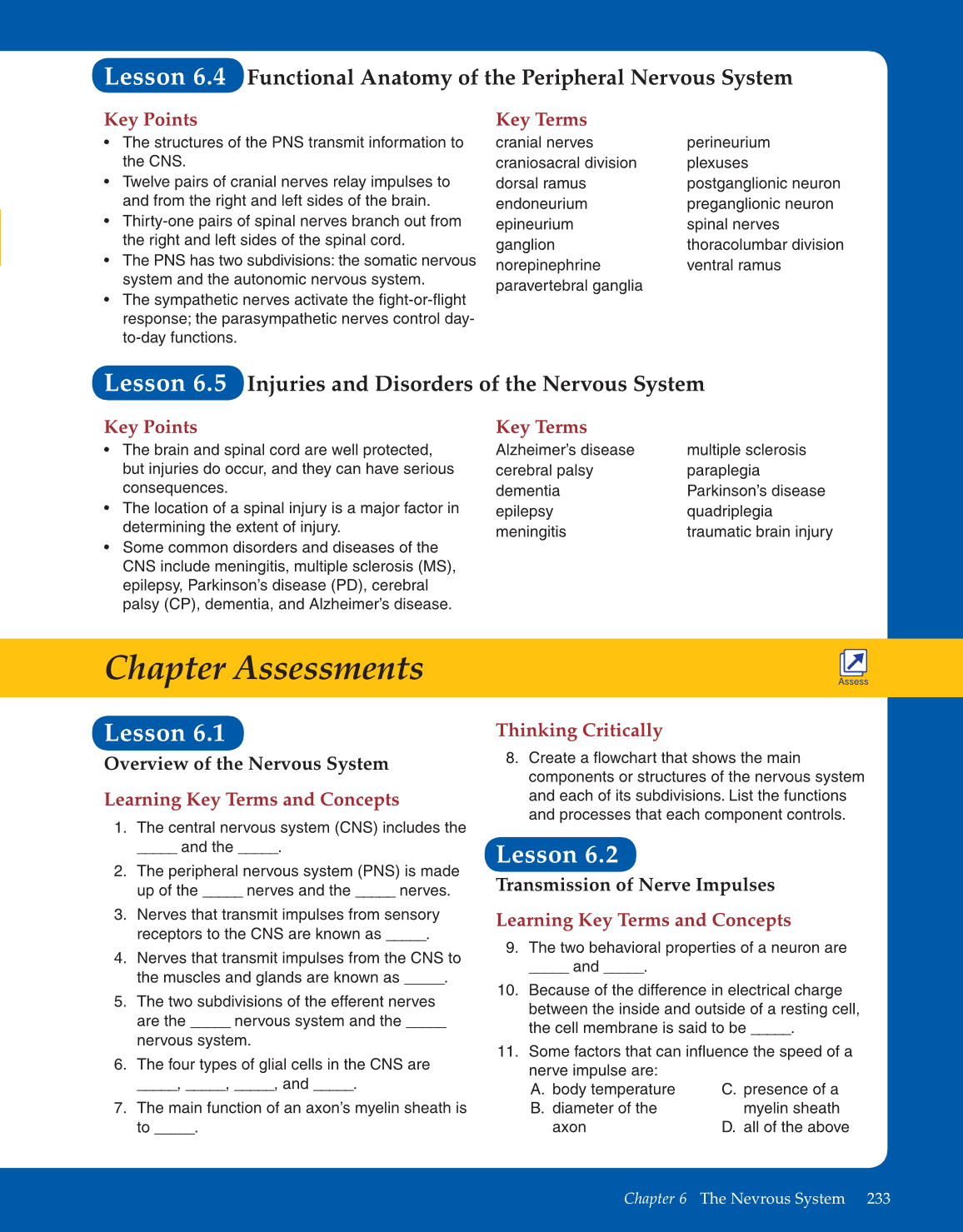Chapter 6 The Nevrous System 233
Lesson 6.4
Functional Anatomy of the Peripheral Nervous System
Key Points
• The structures of the PNS transmit information to
the CNS.
• Twelve pairs of cranial nerves relay impulses to
and from the right and left sides of the brain.
• Thirty-one pairs of spinal nerves branch out from
the right and left sides of the spinal cord.
• The PNS has two subdivisions: the somatic nervous
system and the autonomic nervous system.
• The sympathetic nerves activate the fi ght-or-fl ight
response; the parasympathetic nerves control day-
to-day functions.
Key Terms
cranial nerves
craniosacral division
dorsal ramus
endoneurium
epineurium
ganglion
norepinephrine
paravertebral ganglia
perineurium
plexuses
postganglionic neuron
preganglionic neuron
spinal nerves
thoracolumbar division
ventral ramus
Lesson 6.5
Injuries and Disorders of the Nervous System
Key Points
• The brain and spinal cord are well protected,
but injuries do occur, and they can have serious
consequences.
• The location of a spinal injury is a major factor in
determining the extent of injury.
• Some common disorders and diseases of the
CNS include meningitis, multiple sclerosis (MS),
epilepsy, Parkinson’s disease (PD), cerebral
palsy (CP), dementia, and Alzheimer’s disease.
Key Terms
Alzheimer’s disease
cerebral palsy
dementia
epilepsy
meningitis
multiple sclerosis
paraplegia
Parkinson’s disease
quadriplegia
traumatic brain injury
Chapter Assessments
Assess
Lesson 6.1
Overview of the Nervous System
Learning Key Terms and Concepts
1. The central nervous system (CNS) includes the
_____ and the _____.
2. The peripheral nervous system (PNS) is made
up of the _____ nerves and the _____ nerves.
3. Nerves that transmit impulses from sensory
receptors to the CNS are known as _____.
4. Nerves that transmit impulses from the CNS to
the muscles and glands are known as _____.
5. The two subdivisions of the efferent nerves
are the _____ nervous system and the _____
nervous system.
6. The four types of glial cells in the CNS are
_____, _____, _____, and _____.
7. The main function of an axon’s myelin sheath is
to _____.
Thinking Critically
8. Create a fl owchart that shows the main
components or structures of the nervous system
and each of its subdivisions. List the functions
and processes that each component controls.
Lesson 6.2
Transmission of Nerve Impulses
Learning Key Terms and Concepts
9. The two behavioral properties of a neuron are
_____ and _____.
10. Because of the difference in electrical charge
between the inside and outside of a resting cell,
the cell membrane is said to be _____.
11. Some factors that can infl uence the speed of a
nerve impulse are:
A. body temperature
B. diameter of the
axon
C. presence of a
myelin sheath
D. all of the above
